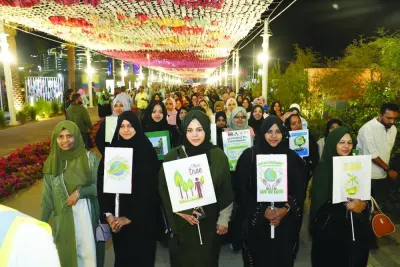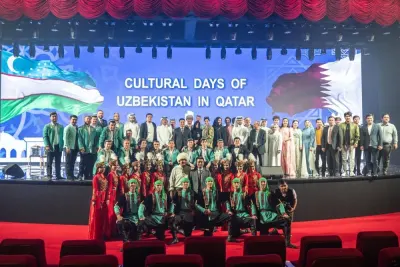THE GOAL: As far as the intellectual journey is concerned, the fact that we get to learn more is definitely the main purpose of the exhibition, says Dr Nur Sobers-Khan. Photos by Jayaram
Once you put the exhibition up, it sort of ceases to be yours. It belongs to the museum, and to the people, who respond to it on their own terms, Dr Nur Sobers-Khan, curator of this new series, tells Anand Holla
Inside dark halls lit merely by the sporadic yellow-glow encircling glass display cases, lies your passport to the past. As the Museum of Islamic Art (MIA) uncovered the second installment of its Building our Collection (BoC) exhibition, featuring objects mainly from Iran and India, the story of the beginning of art collecting in the Islamic world crackled to life.
Dispersed pages from murakkas, which are essentially albums from Safavid-era Iran and Mughal-era India that featured collections of stunning miniature paintings and calligraphic works bound into volumes between the 15th and 19th century, are the stars of this exhibition.
Be it the actual pages from murakkas maintained by Shahs and Sultans or the paintings that belonged to the Mughal and Safavid libraries, the objects on display make for an enriching, enlightening experience.
While the first part of Building our Collection exhibition focussed on rare and beautiful ceramics to Spain so as to highlight the blending of Muslim and Christian artistic motifs, the second part — Mughal and Safavid Albums — explores the artistic culture of Safavid and Mughal courts.
The underlying idea of Building our Collection though is to figure out why MIA collects Islamic art, and how its collecting practices shape our understanding of Islamic art through artistic and cultural connections between different regions of the Islamic world.
Dr Nur Sobers-Khan, a PhD in Ottoman History who previously worked as the Iran Heritage curator for Persian manuscripts at the British Library, is the curator of this new series. Here, she tells Community why this exhibition is special.
What is the most fascinating part of this period of history to you?
I find it quite interesting the way the pre-modern world was very much interconnected. It is something we don’t appreciate today. We tend to think it’s the Internet and the globalisation that has made it possible. However, in terms of trade, there was global trade in the 15th century, and even global artistic tradition, movement of scholars, merchants, diplomats, and migrants, just as we have today. It might not have been this fast but it certainly existed.
What is a Safavid album and why was it popular?
A Safavid album is a lot like a photo album we used to have and maintain until some years ago. So these artistic albums were a collection of beautiful paintings and calligraphic compositions. The owner of the album would compile these images together and appreciate them, look through them, contemplate them, meditate on them.
Usually those paintings would be of the owner and his family?
Actually, they could be anything. Any beautiful images that the person valued for whatever reason would be included. For instance, early Timurid albums, from around the 15thcentury, would typically be a record of artistic production which could be used by other artists. So you would look at sketches other famous painters had created to make a particular painting and use that as an example. That way, it was almost a record of the painting. Later on, Mughal emperors such as Jehangir and Shahjahan had very famous albums. Shahjahan’s album contained portraits of the important members of the court. Occasionally, it would contain portraits of his sons; like the one we have on display here of Shah Shuja. Mughal albums often contain earlier paintings from the Safavid period.
So would they acquire these paintings or commission them to artists?
It was a combination of both. Sometimes, they would collect paintings from an earlier period and sometimes they would commission them afresh. That said, further research is still underway on how they used these albums. It could have been a personal belonging that they enjoyed thumbing through with other members of the court. Even the miniature paintings are relatively big, so they could be viewed by a large group of people.
Tell us about the movement of culture between India and Iran.
India and Iran have a very close cultural connection, and their cultural exchange has a long history. Persian poetry in Nasta’liq script was copied in India at the Mughal courts, while Iranian miniature paintings are very obviously influenced by Indian artistry. Of course, the Mughals themselves are famous because they were originally from Central Asia, followed Persian culture, and with time, became more Indian by intermarrying with local Rajput families and so on.
Artistically, too, would those themes go back and forth?
Yes, of course. A lot of artists would travel back and forth, and hence the objects would too. In the late 16th century, Shah Tamas, a Safavid ruler in Iran, ceased his patronage of the arts because he became very religious. So, many of the artists from his court travelled to India and began to work in the courts of Emperors Humayan and Akbar. There was a direct transfer of artistic practices and knowledge because the artists themselves travelled. Artistic objects such as manuscripts and paintings would also travel because they would often be given as diplomatic gifts.
Did you have to source any of these 27 objects that are on display?
All of them come from our own collection at MIA. The only objects that aren’t part of it are the raw materials that the artists then used; the colour pigments, pens, and brushes made out of hair from the tip of the tail of the squirrel. The colours, for instance, are from my personal collection. I had purchased them from London.
How complex is the process of putting this exhibition together?
It’s a very long process that started about a year ago. It’s a huge team of people who have made this happen. I’m more like the spokesperson for it. From a series of curators to the paper conservator to heads of departments, everybody comes together to discuss what the exhibition themes would be and which objects would be selected. Since the majority of MIA’s collection lies in storage, our temporary exhibitions such as this one, gives us an opportunity to do more in-depth research on our objects before we put them on display. Each object is unique and has an elaborate story.
What do you hope to achieve with such an exhibition?
A lot of what we do here at MIA is to enrich the cultural life of Qatar. By putting these objects on display, by telling these stories and engaging in cultural exchange, we hope everyone benefits from it, gets inspired and educated.
What, to you, is the most satisfying aspect of putting together an exhibition?
As far as the intellectual journey is concerned, the fact that we get to learn more is definitely the main purpose. Once you put the exhibition up, it sort of ceases to be yours. It belongs to the museum, and to the people, who respond to it on their own terms.
Artistically, how evolved and sophisticated were artists of that era? Also, how relevant is that art today?
They were extremely sophisticated. But it’s difficult to objectively evaluate sophistication. In my opinion, miniature paintings and calligraphy are highly sophisticated art forms. Even to understand and appreciate the symbolism, the use of proportion and the methods, require a large degree of historic analysis. And they are very relevant as well. The whole point of the exhibition is to focus on the importance of Islamic Art, why we collect it, and to look at it from a historic perspective. For instance, Indian and Persian miniature paintings trickled into British museums because the tradition was picked up by the British who were imitating elite Muslim art collectors. So we try and understand why the Safavids, the Mughals and the British collected art, and also why we collect it.
So, why do we collect art?
Gosh! This exhibition is the answer, basically. We collect art because it allows us to understand something about the past in greater detail, and something about the present as well. These paintings are still very relevant. We still find them beautiful, in terms of pure aesthetic artistic appreciation of beauty. Besides, collection for art for reinforcing cultural prestige is very relevant today. Every country is engaged in that process. Art as a means of education and intellectual refinement is very relevant to do what we do as a museum. Also, the themes explored are universal human themes that never lose their importance — sadness, love, death, beauty, power. If you look further back, you will find those themes explored again and again. The beauty of art and the reason why we value it is that it allows us to express these universal eternal themes of human existence.
We haven’t changed much then, have we?
Humans… (pauses) No, I don’t think we have changed much.
BELOW:
1) AESTHETIC: A miniature work on display.
2) MUGHAL ERA GLORY: Portrait of Shah Shuja, son of Mughal emperor Shah Jahan, Mughal India, mid-17th century. Ink, opaque watercolour, and gold on paper.



